Exclusive Excerpt: Exploring Wine Regions, Bordeaux
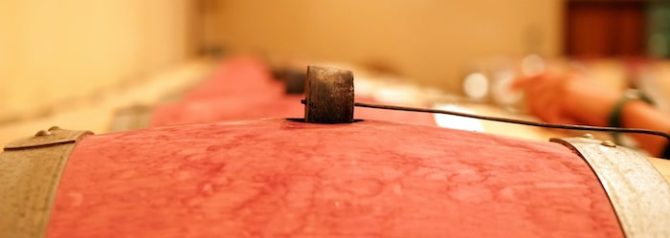
Calling all wine lovers. There’s a new book coming out this month that promises a healthy dose of escapism. Packed with 950 spectacular photographs, “Exploring Wine Regions: Bordeaux” is part coffee-table book, part wine guide and part travel guide to the region of Bordeaux from wine writer and expert Michael C. Higgins. You’ll enjoy entertaining stories on an educational journey exploring the top wine regions of Médoc (Margaux, Pauillac, etc.), Graves (Pessac-Léognon and Sauternes), Saint-Émilion, Pomerol and Fronsac. You’ll even take a side trip to Cognac to visit a cooperage. Below we share an exclusive excerpt from the book.
Pssst. You can purchase the book “Exploring Wine Regions – Bordeaux France: Discover Wine, Food, Castles, and The French Way of Life” by clicking here.
So you love Bordeaux wines? So do I.
This is Old World winemaking at its best. With numerous traditions mixed with innovations (sometimes), price and quality can be subjective and is debated. Plus labeling can be difficult to decipher and absent of important information. It is just the way the French produce wine. Complex. Intricate. Involved. Tricky.
If you are like me, you found a few great Bordeaux wines that you love. Or you discovered the appellation that appeals to your palate the most and you stick to wines coming from that region. Simple. Straightforward. Satisfying. Yet without exploration and further discovery.
How much do you really know and understand Bordeaux? Maybe you are like me and know a few things like Left Bank versus Right Bank, and yet not really know all the nuances of each terroir? And when you discovered there were 60 appellations on 120,000 hectares (297,000 acres) with over 7,000 wineries producing more than 10,000 different bottles annually in Bordeaux… you say to yourself, oh my gosh, now what? And then you add the reputation of the first-growths classifications of 1855. Why does the French Emperor Napoléon III still get to declare the best wines 150 years after his death?
My goal is to uncomplicate Bordeaux so that you can enjoy everything about it… their wines, their wineries and the nuances that make them great. So you can visit in extraordinary ways and venture behind-the-scenes like an insider. And so you can stay on their beautiful properties, and even in castles! Let’s start by exploring the Médoc and some of their delicious appellations.

Michael C. Higgins PhD
Bordeaux – Appellations of the Médoc
One of the things I love about the Médoc is the huge properties with castles, or châteaux as they call them. Many of these castles were built on their massive properties to show off the wealth of the owners. Today, we get to enjoy their grandeur, tour many of them, and even stay the night in some of them. I point out which are which, and you definitely want to go see them!
The other castles here were built for defense. There have been many battles fought in the Médoc and real fortresses still exist here, including moats and other fighting features.
The Médoc is where all the red wine Grand Cru Classés of 1855 are located; except one, Château Haut-Brion, which is in Pessac. The only other place for Grand Cru Classés of 1855 is in Sauternes for the golden sweet wines.
The Médoc is also where all the Cru Bourgeois wines are located, exclusively. In the pages of the book, I bring to you only Cru Bourgeois and Grand Cru Classé châteaux. And only those châteaux that are open for visitors, and especially those who put on excellent tourism experiences.
The entire Médoc appellation is known as the “Left Bank” and covers an area over 16,500 hectares (40,772 acres) that are actual AOCs authorized for producing Médoc identified wines. Maps in the book identify the Médoc wine region in different shades.
Within the larger Médoc appellation there are eight sub-appellations, which include a Médoc sub-appellation as well as an Haut-Médoc sub-appellation. There are six communal appellations: Margaux, Moulis-en-Médoc, Listrac-Médoc, Saint-Julien, Pauillac, and Saint-Estèphe.
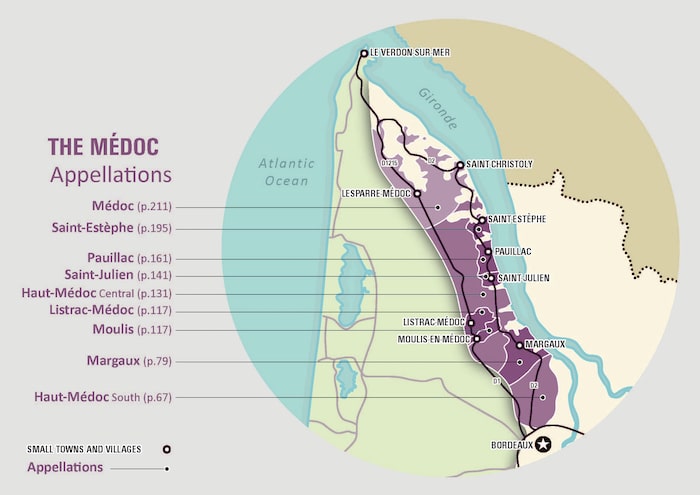
A map of Medoc
Easy Day Trips From The City
The Médoc has a sub-appellation called Haut-Médoc, the largest of all the sub-appellations. I was puzzled why “Haut” means “high” in French, and yet the top Médoc is at the bottom of the Médoc? Even locals did not have an answer. I realized it was not about north and south being top and bottom, it was upstream versus downstream. The upstream (upriver of the Gironde) is higher, meaning the Haut-Medoc. Voilà!
Being such a large area, I separate the southernmost part of the Haut-Médoc, south of Margaux, as it has châteaux which are so close to the city of Bordeaux that they make for easy day trips. You can reach any of the châteaux here in less than a 30-minute drive from the city of Bordeaux.
Since the Haut-Médoc has only five of the 1855 classified châteaux (two are in this southern area), it has become the mecca of the greatest number of Cru Bourgeois châteaux. Many châteaux here are producing volume wines, so choosing Cru Bourgeois or Grand Cru Classé châteaux will keep you out of trouble. I am introducing you to four excellent Cru Bourgeois châteaux that not only have great wine, they also have great tourism experiences, including culinary opportunities.
Château d’Agassac has a gourmet restaurant in their castle, Château Paloumey has a wine and cheese rooftop, and Château du Taillan is an excellent picnic spot and can create a luxurious dinner.
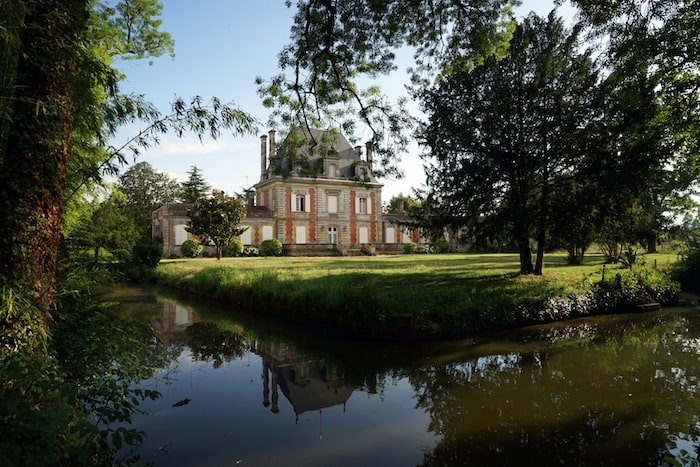
Saint Ahon
Soft Feminine Margaux Appellation
In the land of big bold Cabernet Sauvignon of the masculine Médoc, Margaux is a unique sub-appellation with the bigness of everything we love about Cabernet Sauvignon, yet possessing a delicate softness that I can best call feminine. I find it enchanting. And the Château Margaux “magic” I tasted in their wine is real!
Looking back, the Margaux appellation was the first Bordeaux area cultivated for vineyards. There is evidence that the Romans planted grapes here 2,000 years ago. How did the Romans know of such superior land, of all the lands in the Médoc?
Margaux boasts the thinnest topsoil in the Médoc with the highest proportion of gravel that generates significant heat in the evenings and allows the soil to drain very well. Special terroir.
There are more classified growths in Margaux (21) than any other appellation. Encompassing several villages there is much charm to be found here, including numerous restaurants such as Le Savoie and Restaurant Nomade.
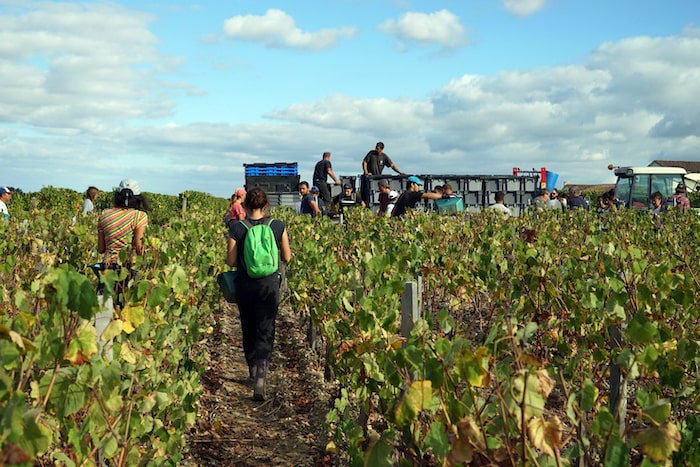
Du Tertre
Small Special Saint-Julien Appellation
Saint-Julien is a small appellation immediately south and adjacent to the famed Pauillac appellation of classified first-growths. Saint-Julien may be small in size; however, big on talent with excellent terroir.
The land here is covered with gravel and pebbles, which provides the naturally regulated soil temperature especially important for Cabernet Sauvignon, the primary grape grown here. The gravelly ridges, where the vineyards are planted, create excellent drainage very important for the vines. The vineyards lie on a bed of sedimentary rock with a mix of sand, clay and sedimentary deposits, creating the magic of the terroir here.
Saint- Julien is also a tiny cute little village in the middle of the appellation. It has a nice lunch spot, Bistrot Chez Mémé, and an amazing goumet restaurant for dinner, Le Saint- Julien. There are four very special châteaux to introduce you to in this appellation. They are all Grand Cru Classés of 1855 and really bring to light the quality and tourism opportunities of this little appellation and community.
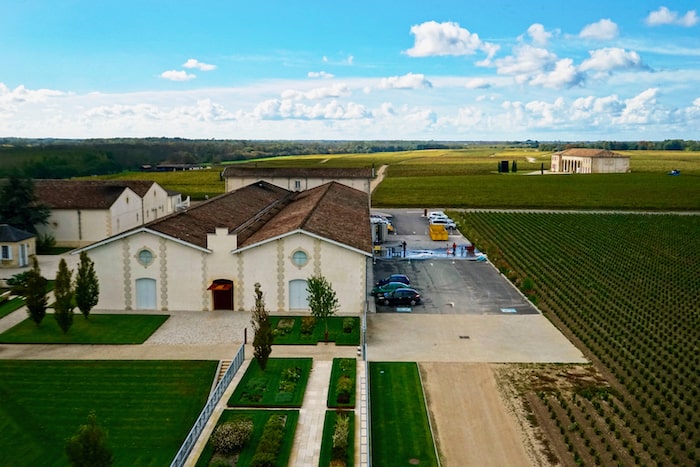
Château Gruaud Larose
Most Prestigious Pauillac Appellation
We started this book by considering that Bordeaux was the center of the wine universe. Once we drill down into the wine regions here, we recognized the Médoc as the key appellation of the grand estates, the Grand Cru Classés of 1855 and Cru Bourgeois wines. Drilling further, Pauillac is the sub-appellation that is most recognized appellations, deemed by many as the undisputed capital of the Médoc.
Pauillac wines are some of the most prestigious in the world, giving rise to 18 Grand Cru Classés in 1855, including three (of only five) first-growths (Lafite-Rothschild, Latour and Mouton-Rothschild). The terroir here is unique, especially the soil, and is considered the ultimate for Cabernet Sauvignon. Deep concentrations of large gravelly stones on top of sand (with clay in the sub-soils) and vineyards planted on slopes and hillsides, allow for good water drainage. At the same time, this causes the roots to grow deep, struggling to reach the water-absorbed clay during crucial dry spells. Not good for most crops; however, these are the optimum conditions for Cabernet Sauvignon. The magic of Pauillac.
This is an appellation where all the Grand Cru Classés are competing heavily to have first-growth qualities. And succeeding. In 1990, for example, many consider Pichon Baron and Lynch-Bages to have made better wines than the first-growths! This is the place to explore Cabernet Sauvignon.
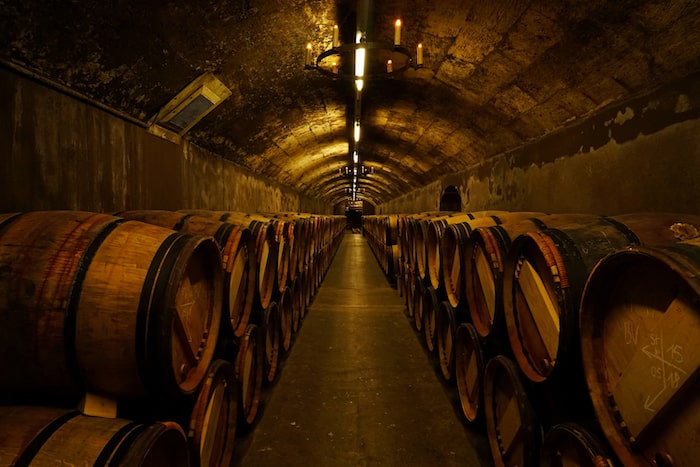
Mouton Rothschild
Clay in Saint-Estèphe Appellation
Saint-Estèphe is the most northern communal appellation in the Médoc along the gravelly western shores of the Gironde Estuary. While Saint-Estèphe is just north of Pauillac, only separated by a stream, the soil composition changes here, giving this appellation its own distinctive AOC. Five classified growths of 1855 are located here and numerous Cru Bourgeois.
The soil distinction is rather significant. Being farther downstream from the Garonne River, there is much less gravel and the stones are smaller. Plus, there is clay in the soil here! Clay brings out the Merlot and this is exactly what the châteaux are planting. And they continue to plant greater and greater ratios of Merlot as they discover how well it performs. Further, the clay retains water which becomes extremely helpful in drought years.
The benefits to us from this Merlot-rich ratio in the Saint-Estèphe wines is the beautiful palate of softness and elegance, which also allows for earlier consumption of their wines. While 10 years is typical for minimum aging (and these wines will still go the distance), they can be approachable in as little as a few years, especially with decanting.
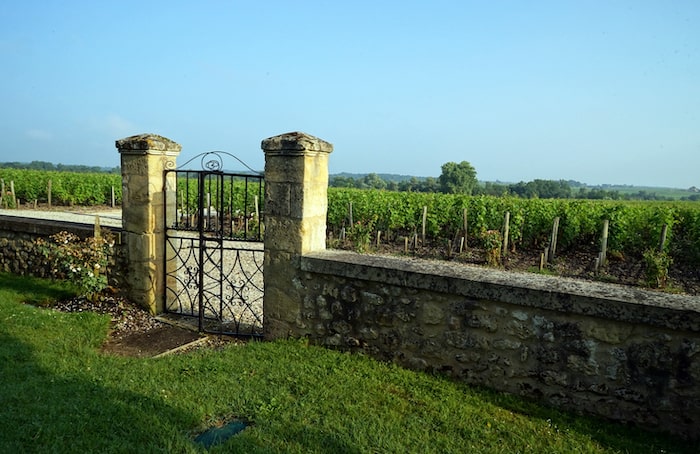
Lafon Rochet
The Médoc Wilds
The Médoc is both the entire Médoc Appellation, which included the seven sub-appellations, and also its own separate sub-appellation at the northern most tip of the Médoc, beyond Saint-Estèphe. This is the end of the Médoc before reaching the ocean.
This is the last stop for the deposits brought down from the Garonne River, Dordogne River and the Pyrénées Mountains, held back by the strength of the Atlantic Ocean as it pushes into the Gironde Estuary. Here lies the prominent gravel and stones from the Garonne River conducive to Cabernet Sauvignon in the Médoc, as well as clay and limestone from the Pyrénées and Dordogne River most special for growing Merlot. And the soil varies dramatically throughout this appellation, giving distinction to each châteaux’s wines; a special expression of their own terroir.
If you want to get away from it all, here is the countryside farthest from the city. The châteaux are spread apart from each other and the vineyards are less dense than those further south. Welcome to the Médoc. The land of serenity. A peaceful intermingling of vineyards with other types of agriculture and animals. This is what I call The Wilds of The Médoc.
On my way to Château Loudenne here, I found myself peacefully off a country road, entranced by cows, in this painting-like setting of the grassy meadow.
Purchase the book Exploring Wine Regions – Bordeaux France: Discover Wine, Food, Castles, and The French Way of Life by Michael C. Higgins PhD here
Share to: Facebook Twitter LinkedIn Email
Leave a reply
Your email address will not be published. Required fields are marked *

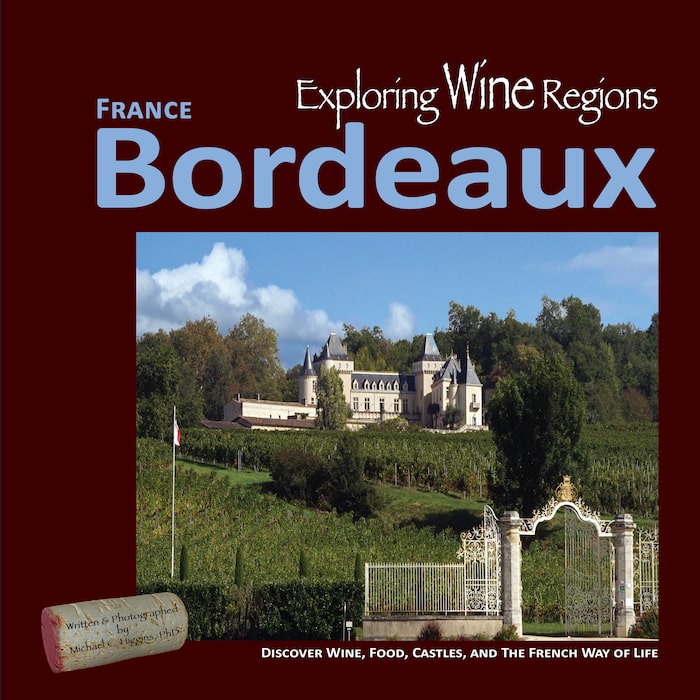



REPLY